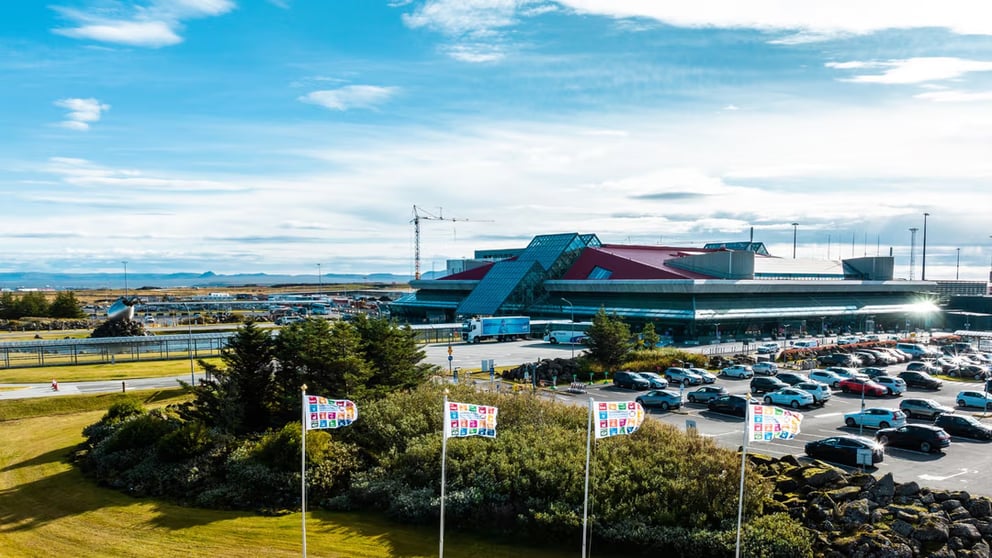Keflavik Airport Guide | Arrivals, Transport, Car Rental & Insider Tips
Keflavik Airport Guide: Arrivals, Transport, Car Rental and Insider Tips
Keflavik International Airport is the gateway to Iceland for nearly all international visitors. Although the terminal looks simple, there are patterns, bottlenecks and small decisions that can make the first hour of your trip effortless or unnecessarily stressful. This guide focuses on everything that really matters when you land in Iceland, with insider knowledge that most airport guides never mention, especially if you are planning to rent a car and start exploring immediately.
Click here for the offical website for Keflavik Airport.

What Travelers Need to Know About Keflavik International Airport
Keflavik Airport sits on the Reykjanes Peninsula, about 50 kilometers from Reykjavik, and operates as a single-terminal airport with a streamlined layout. Everything is walkable and straightforward. There are no complicated transfer systems, no satellite terminals and no long-distance shuttles between facilities. This simplicity makes it easier to navigate, even when you are tired after an overnight flight.
The most important things to prepare for are passport control waves, weather exposure and choosing the right transport option to begin your journey.
If you need to park your car at KEF Airport, then you are going to need this app.
Keflavik Airport Arrivals: Layout, Passport Control and Baggage
Terminal overview and passenger flow
After disembarking, you follow clear signage to passport control. The arrivals level includes passport control, baggage claim, customs and exits into the public arrivals hall. Because everything is located in one continuous flow, there is minimal risk of confusion. The main challenge can be crowding at peak times when several flights arrive close together.
Beating the arrival queues and timing the passport control waves
Keflavik operates in arrival waves, especially early morning and late afternoon. When several transatlantic flights land at once, passport lines can become long. A smart strategy is to use the time right after landing to refill your water bottle, visit the restroom and prepare your documents rather than rushing directly into the longest part of the queue.
Baggage claim patterns and dealing with delays
Baggage delivery is generally efficient, but delays are most common during peak waves. Screens above each belt show flight numbers, and bags usually start appearing only once the belt is assigned. If your luggage is delayed, the service desk is located at the far end of the hall. Take photos of your baggage tag and boarding pass to speed up any report you may need to file.
Transport From Keflavik Airport: Your Options Explained
Airport car rental and shuttle pickup
For travelers who want freedom to explore Iceland, renting a car at Keflavik Airport is the most flexible option. Iceland Car Rental operates a shuttle service that takes you directly from the terminal to the rental station. Instructions and pickup locations are detailed in our shuttle bus from Keflavik Airport guide, which explains where to wait and how the transfer works.

Driving from Keflavik to Reykjavik: road conditions and timing
The 40 to 50 minute drive to Reykjavik follows Route 41, a well maintained paved road. In winter, strong winds and icy patches are common, so take your time. Before driving, it is always wise to check live conditions from the Icelandic Road Authority at road.is. If your plan is to begin a longer adventure right away, you can plan your first route using Your Guide to Planning a Road Trip in Iceland or explore scenic options in The Best Road Trips in Iceland.
How to visit the Blue Lagoon from the airport
Because the Blue Lagoon is only about 20 minutes from the airport, many travelers visit immediately after landing or just before departure. For step by step routing, timing and transport options, see How to Get from Keflavik Airport to Iceland's Blue Lagoon.
Keflavik Airport Facilities: Food, Services, SIM Cards and WiFi

Restaurants, snacks and coffee: what’s worth it
Food at Keflavik is a mix of cafes, grab and go counters and casual dining. Prices are higher than in the city, so many visitors choose to eat lightly here and have a proper meal later. If you want a better selection near the airport, look at The Top 10 Best Restaurants in Keflavik for options in the surrounding town.
SIM cards, eSIMs and the best mobile data options
SIM cards are available at convenience stores in the arrivals hall, including prepaid data packages from major Icelandic carriers. These shops are often busy right after large flights land. If you want to avoid queues, an eSIM activated before arrival may be more efficient. SIM kiosks typically stock options from Siminn, Nova and Vodafone.
ATMs, currency and what you really need
Iceland is almost entirely cashless, so you can pay for nearly everything at Keflavik with a card, including vending machines and fuel stations. ATMs are available, but most travelers complete their entire trip without using cash. If your card has trouble on the first transaction, try a small purchase to ensure proper authorisation before you reach a fuel pump.
Sleeping or Resting at Keflavik During Layovers
Keflavik is not designed as a sleep-friendly airport, but long layovers happen and overnight travelers do rest in quiet corners. Some gates have more comfortable seating than others, so explore before settling in. The Icelandair Saga Lounge offers quieter seating, food, drinks and showers for eligible passengers or those with access programs, making it the best option if you want real rest.
Essential Tips for Driving in Iceland After Leaving Keflavik
Do you need a 4x4 for your route
The right vehicle depends heavily on season and destination. A standard car is fine for city travel and major routes, but a four wheel drive offers greater stability in winter or on gravel roads. To decide, refer to Do I Need a 4x4 Rental in Iceland?.
Understanding rental insurance and exclusions
Insurance varies across rental companies, and Iceland’s conditions can lead to unexpected issues if you are not prepared. Gravel damage, wind damage and highland restrictions are especially important. Ask questions at the desk and take time to understand what is covered, even if you are eager to start your trip.
Avoiding damage from wind and gravel
The Reykjanes Peninsula is known for strong winds that can bend car doors if opened too quickly. Always hold your door firmly when getting in or out. On gravel or mixed surface roads, drive slowly and stay centered to reduce the risk of loose stones striking the sides of your vehicle.

Route 41: What First-Time Visitors Need to Know
Route 41 is the main road between Keflavik and Reykjavik. Although it is straightforward, the speed changes and weather patterns can surprise new visitors. Local drivers may be confident in conditions that are new to you, so do not feel pressured to match their pace. Take your time, stay in the right lane and drive steadily. In winter, expect strong crosswinds that can affect your steering on exposed stretches.
Weather at Keflavik Airport: Microclimate, Wind and Safety
Weather around Keflavik changes rapidly. Strong gusts, low visibility and sudden rain or snow are normal on the peninsula. Check the latest conditions with the Icelandic Met Office at en.vedur.is before driving. Cold air and wind chill can make the outdoors feel much colder than the temperature suggests, so dress appropriately and keep gloves or a hat easily accessible in your carry on.
Fuel, Groceries and Smart First Stops After the Airport
As you leave the airport, several service stations and supermarkets appear along the way to Reykjavik. Stopping once to gather fuel, snacks or basic groceries is more efficient than making multiple short stops later. For guidance on fueling across Iceland, see Your Guide to Fuel Stations in Iceland.
Short Trips Near Keflavik: What to See During Layovers
The Reykjanes Peninsula is full of geothermal landscapes, sea cliffs, lighthouses and volcanic features. If you have a layover of a few hours and access to a rental car, you can see a surprising amount with minimal driving. Combine a stop at the Blue Lagoon with a coastal drive or explore the dramatic lava fields surrounding the airport area. These short excursions offer a meaningful first taste of Iceland without long distances.

Returning Your Rental Car at Keflavik and Preparing to Depart
How early you need to arrive for security
Airlines generally recommend arriving around two and a half hours before European flights and about three hours before flights to North America. Traffic toward the airport can be heavier in the morning, so plan extra time for the drive and shuttle return. If you are returning a rental car, factor in time to refuel, unload luggage and complete the inspection.
Shuttle return timing and traffic patterns
Early mornings are the busiest for departures, so the rental shuttle may have more passengers waiting. If you want to be at the airline counter early, consider leaving your accommodation slightly sooner or finishing your fueling the night before if your schedule allows.
Final Travel Tips for a Smooth Start to Your Iceland Trip
Keflavik Airport may be small, but understanding its flow and preparing for local conditions can make your arrival seamless. Hold your car doors securely in the wind, check the weather before driving and choose the right vehicle for your itinerary. For a smooth transition from terminal to road, use the shuttle bus from Keflavik Airport guide, plan early stops with the Blue Lagoon transfer guide and map out your route with the Iceland road trip planning guide. With a little preparation, your first hour in Iceland becomes the easiest part of your adventure.


